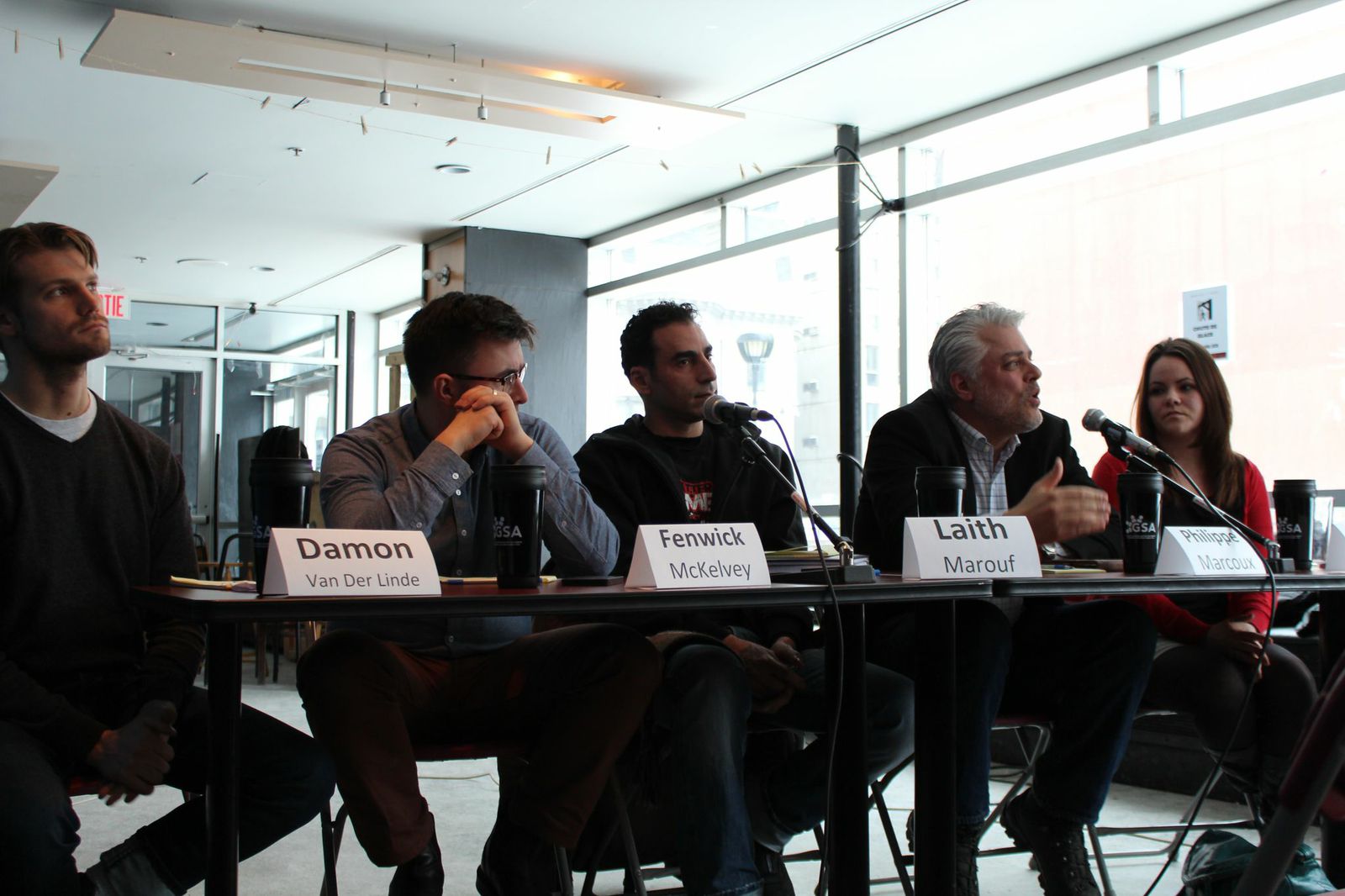Panel of experts discuss the role of media and the nature of coverage in social movements
How does the media view social movements? Can journalists be activists? From yesteryear’s feminism and anti-war movements to today’s austerity marches and student protests, the question of how the media packages, frames, and interprets such acts is increasingly under scrutiny.
The event came on the tail end of Concordia’s Solidarity Teach-In week, a multi-day program of exchanges, workshops, and discussions leading up to the anti-austerity actions of spring 2015.
The panel featured freelancer (and former The Concordian News editor) Kalina Laframboise,
activist and producer Laith Marouf, veteran Radio-Canada journalist and assistant professor in the journalism department Philippe Marcoux, communications department assistant professor Fenwick McKelvey, and multimedia journalist Damon van der Linde.
The discussion revolved around perceptions of objectivity, the perceived hostility of traditional media towards disruptive social movements, and the differences between it and independent community media.
Van der Linde, who claims experience from extensive human rights reporting in Africa and elsewhere, believes the aim for journalistic objectivity precludes a reporter from being an activist.
“One of the biggest problems with news striving for objectivity and being a journalist covering social movements is often—not always—[that] social movements have leaders, a certain amount of power, they have political affiliations, there could also be money involved, and it’s all controlled by people,” said van der Linde.
“No one is asking to give equal space in an article or in a report, or equal credibility to both sides of a story,” said van der Linde, using the example of climate change. “But if you leave out a voice because it doesn’t follow the narrative you believe, then you’re not a journalist.”
Marcoux, owing to his many years working for Canada’s national broadcaster, offered insight on behalf of traditional, established media. “I think it’s really important to point out [that] … no matter how much you insist, [CBC/Radio-Canada] is a public broadcaster and will never be a state broadcaster.” He says influence does percolate within public media, but cautions on overextending its reach. “There is no such thing as a public line that is decided by the government and funneled down to the CBC newsroom. Journalists never hear about the government. The CBC and Radio-Canada [are] not perfect—trust me, I’ve spent my life criticizing them. But the biggest problem about them is not political influence.”
During typical coverage of countercultural events, Marcoux maintained that the people working in front of the camera and behind it are trying their best.
“They may not manage—you are perfectly allowed to think their coverage is biased—but the mistake you would be making is by not understanding that they think they’re striving for objectivity. When you deal with them, understand that they don’t think they have a bias. Use them, don’t use them, try to influence them, that’s up to you—but understand the position they start on.”
So is traditional media an ally or enemy of social movements? That’s the wrong way to look at it, according to Marcoux. “At the very least, they don’t want to be either. That’s the important point.”
This response did not sate everyone.
“CBC/Radio-Canada is just like the Syrian television, or the Portuguese government television. They are mouthpieces of whoever is in power,” said Marouf, one-time executive director of Concordia University Television (CUTV). Marouf maintained Canada’s luck came from having a third alternative to state and corporate media in the form of community media, whose mandate was to give a voice of balance to the mainstream.
“Those who decide to work for government outlets are bound by the editorial positions of their bosses,” he said. “The shortcoming of that is that you have no real control of the message, you are bound by the interests of the media to use that coverage, and you have no say obviously in which direction that content’s going to go.”
Yet the alternative of independent media isn’t too rosy, seeing as they operate in a ‘deeply fractured’ landscape. As an example close to home, he mentioned Concordia’s local media, which for all its efforts and relatively robust funding lacks effectiveness and technological savvy at reaching out the world beyond campus.
“On the one hand these media are very specific in terms of what platform they’re delivering on. With what’s happening at [Concordia] and McGill and UQAM and UdeM, the students have more than $4 million annually in financing—but the outcome for these dollars is very low. Why? Because right now the reality is that people when they’re searching for information on the Internet the traffic is going towards multimedia multiplatform delivery. The mainstream corporate sector … there’ll be audio, there’ll video, and there’ll be text, and they’ll be delivering in a newspaper format and a web format. If Concordia students really want to do something, you have democratic ways to change the realities of these islands of media, and bring them together to have very successful multiplat multimedia outlet that can have much more effect, opening this media out to the community to participate in it, to have access to training,” he said, citing his time at CUTV in the 2012 student protests as an example of positive coverage that outshone mainstream reporting.
“CUTV was successful at the time [of the 2012 student protests] because of its ability to create a symbiosis between all the social media online, around a live broadcast, with a symbiosis of this live broadcast live-stream equipment, and the bodies of a whole team on the street at the forefront of the social movement, broadcasting you live unedited images from the frontlines.”
Whatever the nature of the reporting, Laframboise reiterated at the end something all the panelists seemed to agree with “You’re always going to get flak no matter what you write. It doesn’t matter. Everybody’s biased in one way or another.”




